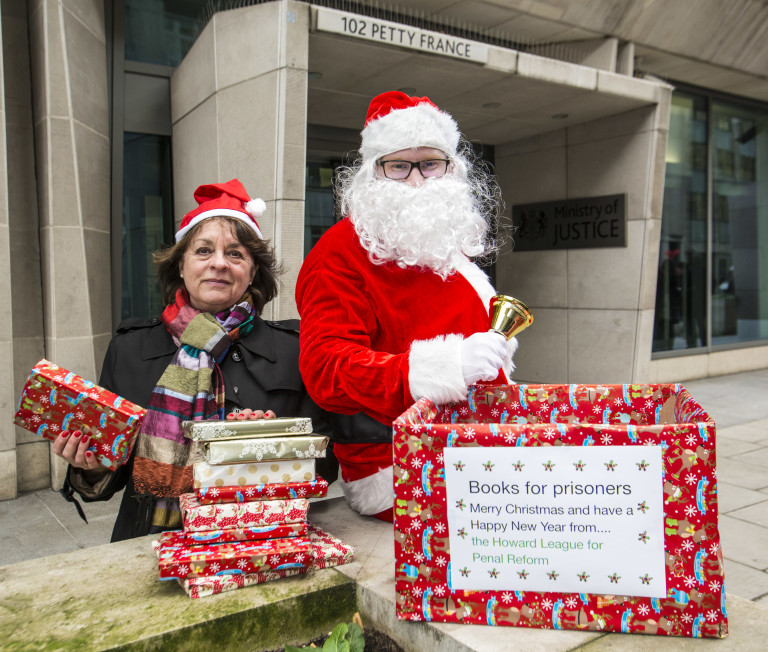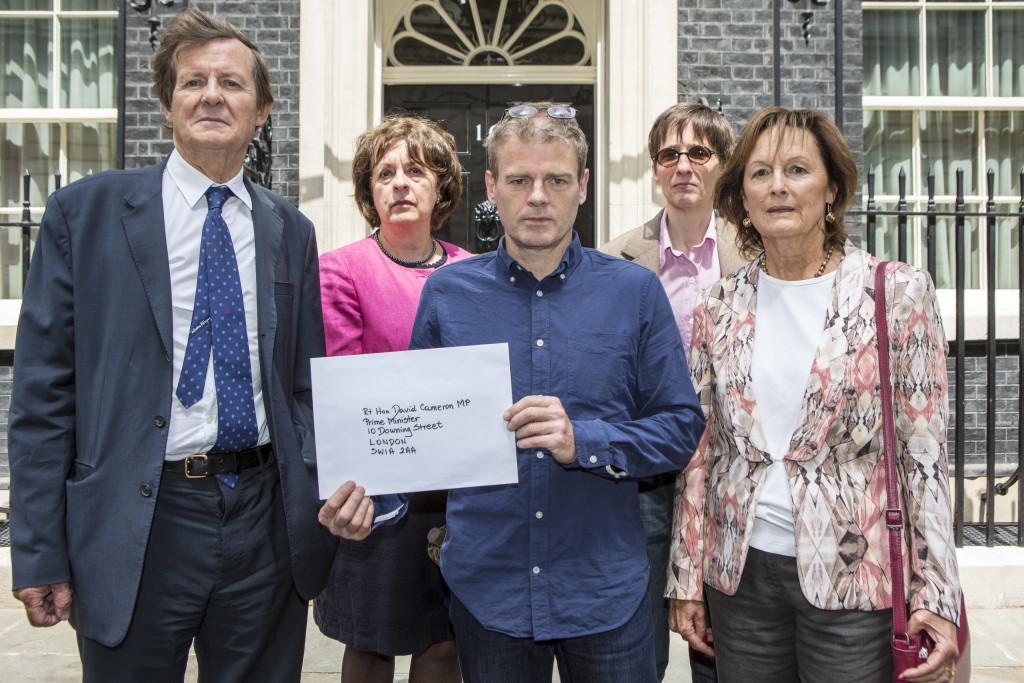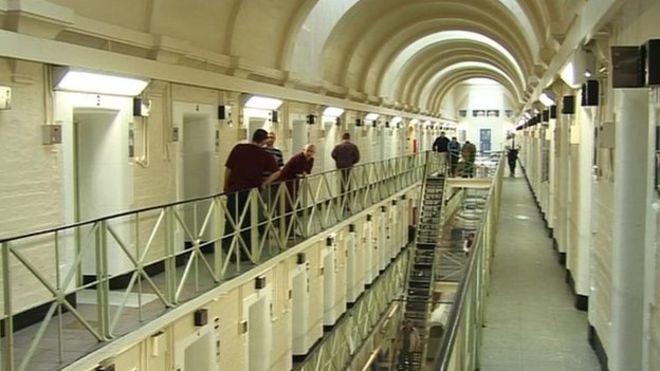Howard League – How to change prisons
By Denise Nanni and Milena Rampoldi, ProMosaik. On the
website of the
Howard League in London I found this important statement: “We
campaign to reduce the prison population and to change prisons. From challenging
restrictions on prisoners reading books to ground-breaking research on sex
behind bars, the Howard League is the leading voice on what should happen
inside prisons“. This was exactly what motivated me to ask for an interview
about Howard League‘ work and activity. Would like to thank Rob about for his
important information.
website of the
Howard League in London I found this important statement: “We
campaign to reduce the prison population and to change prisons. From challenging
restrictions on prisoners reading books to ground-breaking research on sex
behind bars, the Howard League is the leading voice on what should happen
inside prisons“. This was exactly what motivated me to ask for an interview
about Howard League‘ work and activity. Would like to thank Rob about for his
important information.

How was the Howard League founded and why?
The
Howard League is named after John Howard, the founder of the penal reform
movement. Between 1775 and 1790 John Howard made seven journeys across Europe
in search of a humane prison system for English gaols to follow. He conducted
these investigations on his own and financed them himself.
Howard League is named after John Howard, the founder of the penal reform
movement. Between 1775 and 1790 John Howard made seven journeys across Europe
in search of a humane prison system for English gaols to follow. He conducted
these investigations on his own and financed them himself.
In 1866, the Howard Association was formed. Although it was almost eighty years
after the death of John Howard, the founders felt that there was a need to campaign
for reform in the independent style practised by its namesake.
The aim of Howard Association was the “promotion of the most efficient means of
penal treatment and crime prevention” and to promote “a reformatory and
radically preventive treatment of offenders”. In its first annual report in
1867, the Association stated that its efforts had been focused on “the
promotion of reformatory and remunerative prison labour, and the abolition of
capital punishment.”
The Penal Reform League was founded in 1907 with Arthur St John as Secretary.
In 1918, Margery Fry became Honorary Secretary and it was under her guidance
that the Howard Association and the Penal Reform League merged in 1921 to form
The Howard League for Penal Reform.

Why did the prison population increase so much in time?
The answer to this question can be found in this document, published by the Ministry of
Justice, covering the years from 1993 to 2016. Here, among others, it says:
Justice, covering the years from 1993 to 2016. Here, among others, it says:
In 1993, Violence Against the Person (VATP), Sexual
Offences and Drug Offences together accounted for around to in every five sentenced
prisoners (including the recall population).
Offences and Drug Offences together accounted for around to in every five sentenced
prisoners (including the recall population).
By 2016, this had increased to three in five VATP and
Sex Offenders may be given an Extended Determinate Sentence (EDS).
Sex Offenders may be given an Extended Determinate Sentence (EDS).
Around 75% of prisoners serving an EDS as at 30 June
2016 were either VATP or Sexual offenders.
2016 were either VATP or Sexual offenders.
What activities do you carry out in order to transform
prisons?
prisons?
We campaign for change. Recent examples include our
successful fight to overturn a ban on sending
books to prisoners. At the Howard League we know change is possible.
People can change, institutions can be changed, whole systems can be changed.
Here are some examples of how it can be done.
successful fight to overturn a ban on sending
books to prisoners. At the Howard League we know change is possible.
People can change, institutions can be changed, whole systems can be changed.
Here are some examples of how it can be done.
In November 2013, the Ministry of Justice
introduced a blanket ban on loved ones sending in books and other essentials,
such as underwear, to prisoners. This was part of a crackdown on what ministers
described as prisoners’ “perks and privileges”.
introduced a blanket ban on loved ones sending in books and other essentials,
such as underwear, to prisoners. This was part of a crackdown on what ministers
described as prisoners’ “perks and privileges”.
At the Howard League for Penal Reform, we know this
is wrong. People are sent to prison as a punishment, not for a punishment.
Books and essentials such as underwear should not be seen as perks or
privileges. Reading books goes hand in hand with education, with
rehabilitation, with humanity. We should do everything we can to encourage
reading and not restrict a prisoner’s access to books.
is wrong. People are sent to prison as a punishment, not for a punishment.
Books and essentials such as underwear should not be seen as perks or
privileges. Reading books goes hand in hand with education, with
rehabilitation, with humanity. We should do everything we can to encourage
reading and not restrict a prisoner’s access to books.
We
launched the Books For Prisoners campaign in March 2014. In the first week
of the campaign a letter was sent to the Daily Telegraph from many of the
country’s leading authors, thousands of Howard League supporters tweeted
‘shelfies’ to the Ministry of Justice, and the Poet Laureate Carol Ann Duffy
staged a poetry reading – ‘The Ballad of Not Reading
in Gaol’ – outside Pentonville prison in north London.
launched the Books For Prisoners campaign in March 2014. In the first week
of the campaign a letter was sent to the Daily Telegraph from many of the
country’s leading authors, thousands of Howard League supporters tweeted
‘shelfies’ to the Ministry of Justice, and the Poet Laureate Carol Ann Duffy
staged a poetry reading – ‘The Ballad of Not Reading
in Gaol’ – outside Pentonville prison in north London.
As the
campaign progressed, authors delivered a letter to the Prime Minister, David
Cameron, the Howard League staged a silent protest as the Justice Secretary
gave evidence to a parliamentary committee, and Santa visited the Ministry of
Justice as part of ‘A Christmas Carol’. By the end of 2014 the High Court had ruled the restrictions unlawful.
campaign progressed, authors delivered a letter to the Prime Minister, David
Cameron, the Howard League staged a silent protest as the Justice Secretary
gave evidence to a parliamentary committee, and Santa visited the Ministry of
Justice as part of ‘A Christmas Carol’. By the end of 2014 the High Court had ruled the restrictions unlawful.

Santa along with the Howard League and English PEN
delivering books for prisoners to the Ministry of Justice HQ, central London.
delivering books for prisoners to the Ministry of Justice HQ, central London.
In 2015,
the Howard League won a Charity Award 2015 for the Books For Prisoners
campaign, which was described as having “every aspect you could want from a
campaign” by the judges.
the Howard League won a Charity Award 2015 for the Books For Prisoners
campaign, which was described as having “every aspect you could want from a
campaign” by the judges.
What
actions do you address to women? And why did you decide to undertake specific
actions for them?
actions do you address to women? And why did you decide to undertake specific
actions for them?
Here is a link to the work we do to help women in
trouble with the law, and the reasons why we do it: http://howardleague.org/what-you-can-do/women-in-the-penal-system/
trouble with the law, and the reasons why we do it: http://howardleague.org/what-you-can-do/women-in-the-penal-system/
Women are
a minority in the criminal justice system, accounting for approximately 5 per
cent of the prison population and 15 per cent of those supervised in the
community. The reasons that they end up involved in the criminal justice system
are often very different to their male counterparts and their needs tend to be
more complex.
a minority in the criminal justice system, accounting for approximately 5 per
cent of the prison population and 15 per cent of those supervised in the
community. The reasons that they end up involved in the criminal justice system
are often very different to their male counterparts and their needs tend to be
more complex.
The vast majority of women that are sentenced to
prison serve very short sentences for non-violent offences. These sentences
create chaos and disruption for women and their families and do nothing to
help them turn their lives around.
prison serve very short sentences for non-violent offences. These sentences
create chaos and disruption for women and their families and do nothing to
help them turn their lives around.
In 2007,
Baroness Corston published her seminal Review of
Women with Particular Vulnerabilities in the Criminal Justice System, also know
as the Corston Report. It concluded that imprisonment was
disproportionate and inappropriate for the vast majority of women in prison and
that women’s centres and other community services were far more suitable for
almost all women in contact with the justice system.
Baroness Corston published her seminal Review of
Women with Particular Vulnerabilities in the Criminal Justice System, also know
as the Corston Report. It concluded that imprisonment was
disproportionate and inappropriate for the vast majority of women in prison and
that women’s centres and other community services were far more suitable for
almost all women in contact with the justice system.
The Howard League provides administrative
assistance to the All Party Parliamentary Group (APPG) for Women in the
Justice System, chaired by Baroness Corston and Fiona Mactaggart MP. The APPG
works to ensure high quality debate and discussion on issues around women
in the justice system in Parliament and continues to push for the full
implementation of the Corston Report recommendations.
assistance to the All Party Parliamentary Group (APPG) for Women in the
Justice System, chaired by Baroness Corston and Fiona Mactaggart MP. The APPG
works to ensure high quality debate and discussion on issues around women
in the justice system in Parliament and continues to push for the full
implementation of the Corston Report recommendations.
The APPG’s latest report looks at the impact of the
Transforming Rehabilitation reforms on women’s centres.
Transforming Rehabilitation reforms on women’s centres.

In which ways
prison population through prevention?
prison population through prevention?
We have published proposals that, if adopted by the
government, would reduce pressure on the prison system by reducing the prison
population. It is called the 3 Rs of Prison Reform.
government, would reduce pressure on the prison system by reducing the prison
population. It is called the 3 Rs of Prison Reform.
Our overcrowded prisons are not
law-abiding places. Prisons are rivers of crime. We are throwing more and more
individuals into these raging rivers of violence, of drugs, of frustration and
mental distress, and somehow magically thinking that this will make them better
people.
law-abiding places. Prisons are rivers of crime. We are throwing more and more
individuals into these raging rivers of violence, of drugs, of frustration and
mental distress, and somehow magically thinking that this will make them better
people.
It does
not. The river doesn’t steer these people to safe shores but sweeps them away
into deeper currents and further and further into crime. Ultimately that means
more people will be released from prison and go on to reoffend. More members of
the public will become victims of crime.
not. The river doesn’t steer these people to safe shores but sweeps them away
into deeper currents and further and further into crime. Ultimately that means
more people will be released from prison and go on to reoffend. More members of
the public will become victims of crime.
What we
need is immediate action to stem the flow of people into prison and support so
that prison staff can then focus on working positively with those who remain
behind bars.
need is immediate action to stem the flow of people into prison and support so
that prison staff can then focus on working positively with those who remain
behind bars.
Overcrowding and why it matters
The
prison population of England and Wales has doubled in twenty years and the
system now holds many more prisoners than it was designed to hold.
prison population of England and Wales has doubled in twenty years and the
system now holds many more prisoners than it was designed to hold.
Overcrowding
means around 20,000 prisoners are forced to share tiny cells in twos or threes.
The prisoners will not know each other or what they have done. You can go to
sleep one night with a cellmate in the other bunk and the next morning a
complete stranger could be sleeping there.
means around 20,000 prisoners are forced to share tiny cells in twos or threes.
The prisoners will not know each other or what they have done. You can go to
sleep one night with a cellmate in the other bunk and the next morning a
complete stranger could be sleeping there.
Overcrowding
means that prisoners are not placed in the prison most likely to help but
instead where there is simply a bed that is available.
means that prisoners are not placed in the prison most likely to help but
instead where there is simply a bed that is available.
Overcrowding
means that prisoners do not have sufficient access to purposeful activity such
as work or education, or to visit healthcare or receive visits. More and more
prisoners spend up to 23 out of 24 hours a day lying on their bunks doing
nothing. The sheer boredom itself feeds and breeds the problems of violence and
of drug abuse behind bars.
means that prisoners do not have sufficient access to purposeful activity such
as work or education, or to visit healthcare or receive visits. More and more
prisoners spend up to 23 out of 24 hours a day lying on their bunks doing
nothing. The sheer boredom itself feeds and breeds the problems of violence and
of drug abuse behind bars.
Meanwhile,
the manifest needs of most prisoners are not being met. Poor mental health,
drug and alcohol addiction, poor literacy and numeracy: these and other issues
are more likely to be made worse rather than better by a spell inside.
the manifest needs of most prisoners are not being met. Poor mental health,
drug and alcohol addiction, poor literacy and numeracy: these and other issues
are more likely to be made worse rather than better by a spell inside.
Dangerous prisons
Despite
the best efforts of those working in the system, prisons are sinking under a
tide of violence, of rampant drug abuse and increasing evidence of mental
distress among prisoners.
the best efforts of those working in the system, prisons are sinking under a
tide of violence, of rampant drug abuse and increasing evidence of mental
distress among prisoners.
There
were more alleged homicides in 2015 than in any other year on record. Assaults
in prison have risen by 34% in the space of one year. Assaults on staff have
risen by an even greater 43%.
were more alleged homicides in 2015 than in any other year on record. Assaults
in prison have risen by 34% in the space of one year. Assaults on staff have
risen by an even greater 43%.
It is not
just violence against other people, however, but violence against the self. The
rate of self-injury has more than doubled among male prisoners since 2010. The
levels of suicide in prison are the highest since records began.
just violence against other people, however, but violence against the self. The
rate of self-injury has more than doubled among male prisoners since 2010. The
levels of suicide in prison are the highest since records began.
Across
the board, things are not just getting worse but the rate of deterioration is
getting worse.
the board, things are not just getting worse but the rate of deterioration is
getting worse.
If what
was happening every day in prisons was happening in schools or hospitals – even
just one school or hospital – there would be a public outcry.
was happening every day in prisons was happening in schools or hospitals – even
just one school or hospital – there would be a public outcry.
The state
of the prisons is now a national emergency.
of the prisons is now a national emergency.
What needs to be done: the 3 Rs
The
government has announced plans to improve safety but unless it deals with
overcrowding by reducing demand on the prisons then those plans will fail.
government has announced plans to improve safety but unless it deals with
overcrowding by reducing demand on the prisons then those plans will fail.
Bold
sentencing reform to better match the use of prison to the resources available
is required. There is no reason we cannot bring numbers down by a half and have
a prison population of around 40,000 – the same size of prison population we
saw in England and Wales when Margaret Thatcher was Prime Minister.
sentencing reform to better match the use of prison to the resources available
is required. There is no reason we cannot bring numbers down by a half and have
a prison population of around 40,000 – the same size of prison population we
saw in England and Wales when Margaret Thatcher was Prime Minister.
In the
immediate future, however, we need to prevent more violence and more deaths.
The Howard League will outline practical actions in three key areas, actions
that can start to ease the pressure and set us on a journey to reduce prison
numbers. We are campaigning for measures to address the 3 Rs:
immediate future, however, we need to prevent more violence and more deaths.
The Howard League will outline practical actions in three key areas, actions
that can start to ease the pressure and set us on a journey to reduce prison
numbers. We are campaigning for measures to address the 3 Rs:
The 3 Rs of Prison Reform: Recall to Prison
The 3 Rs of Prison Reform: Release from Prison
The 3 Rs of Prison Reform: Rules in Prison



